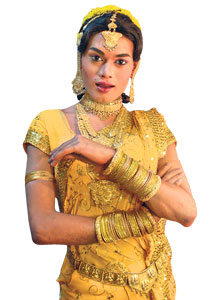In the garish yellow light of the naked bulb, their painted faces look larger than life. They are the 'nachya poras' of Bin Baykancha Tamasha — an eclectic version of the traditional tamasha featuring male dancers in female form.
eclectic version of the traditional tamasha featuring male dancers in female form.
"Aho suna raaya, sanga mee kashi diste?" asks the lead dancer coquettishly, and the audience collectively sighs, to break into loud clapping.
Says Anil Vasudevan, who conceptualised and choreographed Bin Baykancha Tamasha, "This performing art elicits unexpectedly uninhibited responses from the audience, particularly to male dancers."
Vasudevan, a dancer, who put in over 30 years at Mafatlals at a desk job, and then gave it up to adopt choreography as a full-time profession; does make-up for Bharat Natyam artistes, besides choreographing classical and folk performances. In the last two years Bin Baykancha Tamasha has given over 250 performances, and an elated Vasudevan says his boys have enthralled disparate audiences including housewives, politicians, businessmen and corporate executives.
Tickets are priced between Rs 50 and 100, and therefore the dancers are still paid only Rs 200 to 500 per show. The singers are a huge draw, especially Vinay Koli and Jayesh Kale who sing in both male and female voices. Koli who works in Syndicate Bank by the day, says that it is a gift from God. "I cannot act like a woman or dance like a woman, but I can sing better than one!" So is he constantly requested by neighbours and others to sing in both voices? "No, I can't do that," he says candidly. "It's only when I am on the stage that I open my mouth and the voice just pours out…"
Do the dancers ever face an identity crisis? Nitesh Jadhav who is hailed as the most exquisite 'woman' in the show replies in the negative. "It doesn't affect me. Once I wear my sari, I become a woman.” Rajesh Sukant Bodke who is a lecturer at Bodke Classes, and Anil who runs a telephone booth, feel that they would be unable to find this kind of admiration in any other profession, and that the little discomforts do not count in the larger picture. However, Vasudevan admits, "Some men in the audience do laugh at them, but the women simply love them! They are great performers and ultimately that's all that matters."
However, Vasudevan admits, "Some men in the audience do laugh at them, but the women simply love them! They are great performers and ultimately that's all that matters."
The seduction is complete, right from the moment the mujra begins, with the dancers making a dramatic entry, their backs to the audience; and then flinging off their pallus and turning around to face the audience… The Gavlan song follows and then the tongue-in cheek Karbhari Damana, the boisterous Kheltana Rang Bai Holicha and the ever popular Ya Ravji, Basa Ravji…
Clearly, here are Mumbakars eager to take in a spot of culture, not out of the ordinary for a city that thrives on the unusual and the unexpected.
Source: Mumbai Mirror - (contributed by Jaya)
Watch a Video of a NDTV report on the same subject: Men no Bar